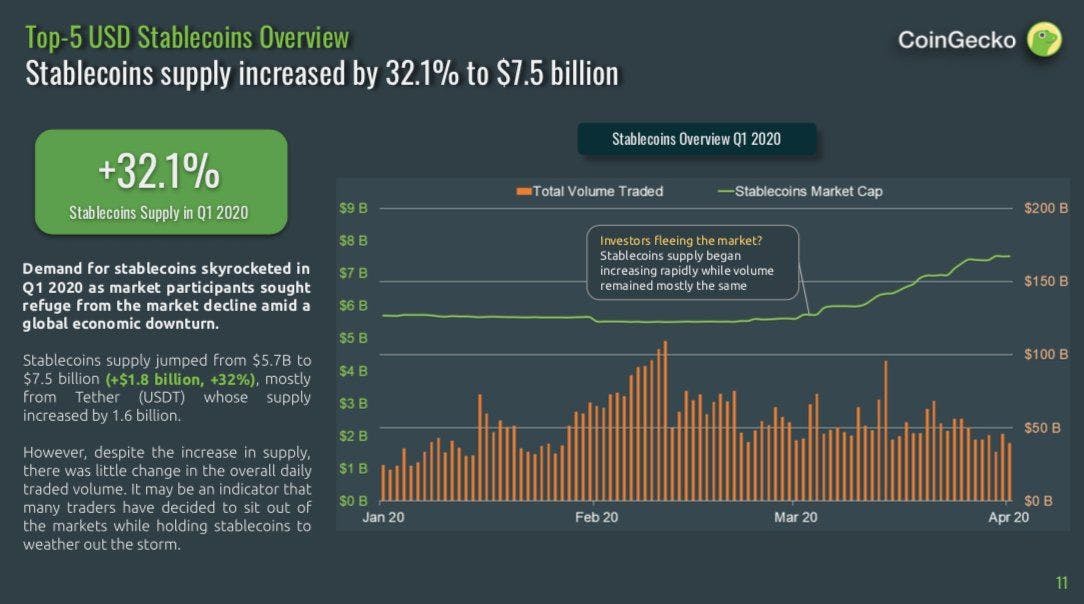Crypto analytics firms Messari, CoinGecko and CoinMetrics released data which shows that the leading smart-contracts blockchain platform Ethereum has now reached parity with Bitcoin in transferred value and may soon exceed it. This rise can be attributed to the rising popularity and explosive growth of Stablecoins in Q1 2020. There are strong indications that this resulted from the global economic slowdown and the mass crypto sell-off earlier in Mar 2020 from COVID-19 pandemic, which saw investors and traders seek safety from the volatility of crypto in Stablecoins.

Ethereum is fast becoming the dominant value transfer layer in the crypto-economic paradigm. The move is being facilitated by the Decentralized Finance (DeFi) industry, that is built almost exclusively around Ethereum. Stablecoins now account for ~ 80% of daily value transfers on Ethereum and are largely issued on the Ethereum blockchain. This is likely to extend further, taking into consideration the maturity of the platform and the network effect of the ecosystem.

Ethereum Stablecoin Issuance
Stablecoin issuance has skyrocketed in Q1 2020, due to the economic decline, rising interest in crypto and people seeking safety against volatility. The Stablecoin supply has increased from $5.7B to $7.5B, showing increase of 32.1% (over 1.8B) in the first quarter of this year, determined from data released by CoinGecko. The largest beneficiary of this growth has been Tether (USDT), whose supply has increased by 1.6B.

Stablecoins are largely been issued on the Ethereum blockchain and the blockchain now hosts the majority of Tether (USDT), because of the technological maturity and high liquidity requirements of the ecosystem.

Besides Tether, other notable Stablecoins such as USD Coin (USDC), Paxos Standard (PAX), Binance USD (BUSD), TrueUSD (TUSD), Multi-Collateral DAI (DAI) and HUSD (HUSD) which saw market capitalization growth in Q1 2020 are all issued exclusively on the Ethereum blockchain.

Why Ethereum Is Becoming The Preferred Transfer Layer?
Ethereum’s reasons for becoming the preferred transfer layer over Bitcoin are multifaceted and relate strongly to the ecosystem. The time taken for a transaction to be confirmed on the Ethereum blockchain is 15 seconds, compared to the 10 minutes timeframe on Bitcoin. The transaction confirmation speed is necessary for faster settlement and provision of liquidity. For instance, traders and investors need rapid transfers or risk losing opportunities, if it takes a long time for them to transfer funds from external wallets to exchanges and back.
The Decentralized Finance (DeFi) mostly exists on Ethereum and currently holds assets worth hundreds of millions of dollars. It has a high requirement of Stablecoins for lending, insurance, collateral requirements, derivatives and payments. Plus most of the crypto-assets are traded against Ethereum on exchanges. The corporate world and institutional investors are further showing interest in the blockchain, because of its massive use cases, which is increasing requirements for liquidity and hedge against volatility.
The Ethereum ecosystem also boasts the top Decentralized Applications (DApps) and Decentralized Autonomous Organizations (DAO), most of which are in the Top 100 list, by market capitalization. It has a lively and thriving developer base, which had a remarkable growth since late. Ethereum is also set to begin transitioning to the next major upgrade of Eth2, in a few months. The Ethereum 2.0 will offer faster speed, performance and less resource consumption. But while the Phase 0 will be launched by the end of this quarter, the upgrade wouldn’t be complete and fully functional before 2022. However, this will improve things further for the Ethereum blockchain, in the long run.

